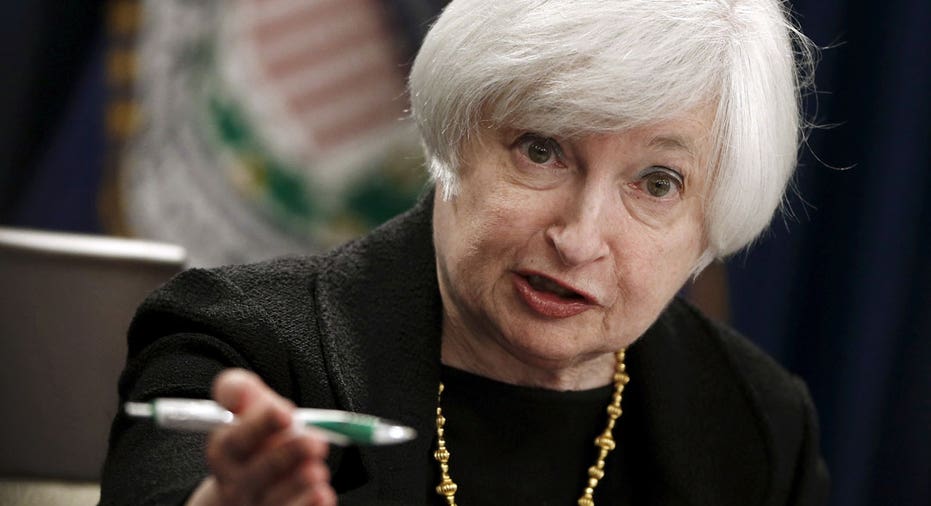Minutes to Show How Yellen Succeeded at Corralling Diverse FOMC Voices

Federal Reserve policy makers were often criticized last year for sending mixed messages as they mulled the timing of the first interest rate hike in nearly a decade. But when it really mattered central bankers banded together around a unified strategy.
Last month the 12 members of the policy-setting Federal Open Markets Committee voted unanimously to lift interest rates off the near-zero range where they’d been held for seven years, marking a highly symbolic departure from the Fed’s easy-money policies initiated in the wake of the 2008 financial crisis.
Fed watchers believe Fed Chair Janet Yellen’s toughest job last year may have been corralling the disparate voices within the FOMC and getting all of them on the same page at the Fed’s decisive December meeting.
“She has very good political skills, you have to to get where she’s gotten and you can tell she has a strong will,” said Ted Peters, chief executive of Bluestone Financial Institutions Fund and a former member of the Federal Reserve Bank of Philadelphia.
Had the vote to raise rates been starkly divided it would have sent the message that “the Fed is undecided, that their decision wasn’t a forceful move,” said Peters. Instead, central bankers were able to “provide a united front.”
Indeed, notwithstanding a wide array of public statements from Fed officials throughout 2015 regarding their personal opinions over the timing and trajectory of eventual rate hikes, the unified message conveyed by the Fed last month supported a December rate hike and that rates should move higher “gradually” going forward into 2016 and beyond.
Divergent Views
What's more, despite all those conflicting public statements, FOMC members throughout 2015 generally found common ground when it was time to vote on policy at the Fed’s policy-setting meetings.
“With such divergent views about monetary policy in the market it is interesting how united the FOMC has been in their views about policy during the year of liftoff,” said Torsten Sløk, chief international economist at Deutsche Bank Securities.
The divergent views on the FOMC ranged from Richmond Fed President Jeffrey Lacker, a vocal inflation hawk who wanted rates to move higher earlier, to Chicago Fed President Charles Evans, a noted dove who advocated delaying liftoff until 2016. Lacker was the lone FOMC dissenter at the September and October meetings during which policy makers voted to hold off on a rate hike.
Historically, the FOMC members, despite the urgency of the times and the importance of the decision facing them, showed a far more unified front in 2015 under Yellen than past FOMC’s under Yellen’s predecessors.
The question now is whether Yellen can continue to hold sway over the FOMC as the debate moves toward how fast rates should rise in the coming years.
Analysts generally agree that the hardest part is over, that since the initial liftoff would garner the most attention from markets and the media it would therefore require the most finesse from Yellen regarding the message conveyed by the FOMC. In that case, mission accomplished.
But with the New Year and the new narrative for interest rate hikes comes a new cast of FOMC voting members. The new members include Kansas City Fed President Esther George, a vocal critic of the Fed’s easy-money policies, and St. Louis Fed President James Bullard and Cleveland Fed President Loretta Mester, both of whom favored raising rates earlier rather than later.
Common Sense Policy
Also joining the FOMC as a voting member is Boston Fed President Eric Rosengren, who has supported the Fed’s interventionist policies under both former Chair Ben Bernanke and current chair Yellen.
"While the new voting members will likely bring a more hawkish tone to the FOMC in 2016, the permanent members are generally viewed as dovish, and their perspective will remain in the majority on the committee," said Brian Rehling, co-head of global fixed income strategy at Wells Fargo Investment Institute.
Regardless of their views over the timing of the first rate hike, no FOMC member has argued with Yellen’s proposed strategy for raising rates “gradually” and with keeping future rate hikes dependent on incoming economic data.
In other words, rates aren’t going to suddenly shoot higher and individual rate hikes will occur only when the economic data justifies such a move. That strategy speaks as much to common sense as it does to any monetary policy ideology.
“These people (FOMC members) are trying to do what’s right for the country,” Peters said. “You may not always agree with them but they don’t have political or personal agendas.”



















